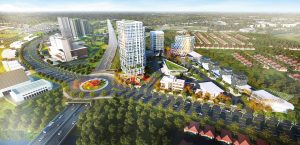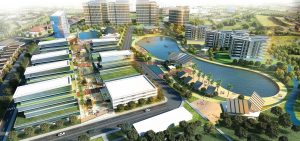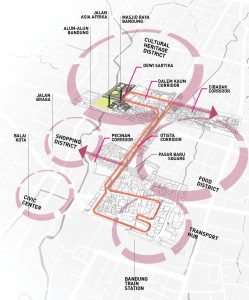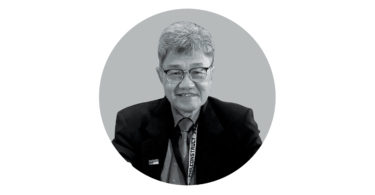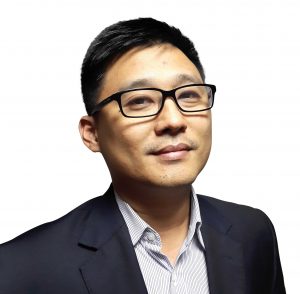 Urban design has always been close to Sibarani Sofian’s heart. Design, he believes, should contribute to problem solving, especially in Indonesian cities.
Urban design has always been close to Sibarani Sofian’s heart. Design, he believes, should contribute to problem solving, especially in Indonesian cities.
After studying architecture at the Bandung Institute of Technology, Sibarani went on to obtain his master’s degree in Urban Development and Design at the University of New South Wales, Sydney, Australia. Upon graduation, he worked in Singapore (TAK Design and RSP Architects) and Hong Kong (SOM Asia and EDAW Asia) before joining AECOM Singapore in 2007. AECOM acquired EDAW Asia, and he was asked to open their Planning and Design division in Singapore. In 2011, he moved to Jakarta to establish Planning and Design in Indonesia until he left AECOM in 2016
Currently, Sibarani is founder and director of URBAN+ practice, which he started in late-2016 together with several key urban and design experts to assist clients and cities in creating compelling urban projects. With their wealth of experience and network, Sibarani and his URBAN+ team are spearheading several strategic infrastructure-driven planning (i.e. transit-oriented developments, Aerotropolis and Port City) and other master planning communities or mixed-use projects, with the aim of developing a better built environment.
He assists several cities and regencies (such as Bogor and Bandung) and serves as an expert source for the Ministry of Public Works, Ministry of State Owned Enterprises, Indonesia Public Housing Board (Perumnas) and Green Building Council Indonesia.
What led you to initiate URBAN+ a year ago?
Working for AECOM was really an eye-opening experience for me. It is the largest design and engineering company in the world with a multi-disciplinary, integrated approach to provide solutions for the build environment, particularly in cities. After gaining 10+ years’ experience managing and leading AECOM’s practice in South East Asia, and recently Indonesia, I wanted to use my good experience to assist more city leaders and urban projects in Indonesia.
What sparked your interest in urban design?
Although I started in architecture in 1993, I was more interested in solving real problems in our surrounding environment—our cities, our streets, our neighbourhoods. I realised, in the later years, that architecture as a profession had limited capacity to address these issues. Back in Bogor—my hometown—in my younger years, I had to help my father in his shop near the Bogor train station and Pasar Anyar market. It was a mess back in the 1980s and was even worse in the late-1990s, and even still is, now in 2018.
I thought that by applying urban design principles, I could help improve the city. So, I decided to deepen my knowledge in urban design; thus, my topic for my final project was Transit-Oriented Development of Bogor Train Station Area, under the mentorship of Prof Mohammad Danisworo. I personally think the expertise of urban designers and its multi-disciplinary eco-system is what cities in Indonesia urgently need.
What is the concept and vision of your firm?
I founded URBAN+ together with Ardzuna Sinaga in late-2016. We believe that current urban issues with its complexities cannot be solved only by one person or one company or one entity. We need to add (+) more experts into a collaborative effort. We are hoping that URBAN+ can be a platform for urban designers to engage with other built environment professionals—such as architects, landscape designers, transportation planners, interior designers, infrastructure planners, etc—to create a collaborative eco-system that can provide positive (+) solutions to cities and communities.
How do you personally see the growth of transit-oriented developments (TODs) in Indonesia?
Transit-oriented development in Indonesia is perceived as an exciting and emerging trend that is a ‘hot’ commodity for both government and private sectors. Unfortunately, both sides see it—or choose to see—not in full totality or unity.
Private developers tend to only see the upside of TODs, which is increase of density (KLB) without looking at the establishment of mandatory supporting factors and infrastructure, such as alternative transit system, transit and pedestrian facilities and linkages, etc., as they consider those as the government’s responsibility.
On the other hand, the government is not always able to provide the infrastructure coherently and comprehensively due to funding issues and are hoping that the private sector will collaborate on these. TOD still needs quite a lot of coordination work between stakeholders, at both private–government and national–regional–cities levels.
Is the TOD only growing rapidly in Greater Jakarta?
TOD naturally will grow along transit corridors, which at this moment is heavily concentrated in the Jakarta–Bogor–Depok–Tangerang–Bekasi (Jabodetabek) area, where commuter trains, MRTs and LRTs are being developed. Jabodetabek is currently the single largest agglomerations of urban areas with the highest density and economic concentration in Indonesia. It is still by far the most desired place to implement TOD, although I would think Palembang, with its implementation of LRT, should already consider TOD, followed maybe by other cities, such as Surabaya and Bandung, which are also implementing LRT or Kereta Api Indonesia (KAI).
What are the positive and negative sides of a TOD?
If done properly, TOD can transform the city area into a highly efficient, diverse, walkable urban centre. Tokyo, Hong Kong and Singapore have implemented TOD several decades ago, and they’re now thriving as great global cities. However, if not done properly, TOD may instead be a burden due to the increased density that may still result in a car dependent, highly fragmented and over-congested city.
What are the main challenges of developing TOD in Indonesia?
Challenges in implementing TOD in Indonesia, in my opinion, lies in mainly two areas. Firstly, how do we shift from car dependency to a mass transit-oriented society? Having a mass transit mode such as commuter trains from KAI, MRT or LRT alone won’t guarantee people are going to use them. It requires a transport system that is integrated with urban planning improvements on a larger district-wide scale. Furthermore, it requires also a high-level policy to limit the number of automobiles and motorcycles. If people still find personal vehicles cheaper and more convenient, they won’t shift to mass public transit.
Secondly, coordination of a larger TOD district level—within a 400 to 800-metre radius from the transit area—not only requires large-scale investment, but a strong coordinator or manager who can balance between private and public interests. Usually, this responsibility lies with the train operator (either KAI or Jakarta MRT) or a department in the city or regional office, or a combination of both. Having said that, I remembered once reading in the newspaper that one of the most difficult things for us, Indonesians, to do is ‘coordination’. We may have the money, acquire the technology and resources or people, but if we can’t coordinate, it won’t work.
Why should TOD be a top priority in Indonesia?
I strongly believe we are going in the right direction, and the government’s focus in developing the infrastructure, especially LRT and MRT, and state-owned enterprises’ synergy as train operators, developers or contractors to speed up the delivery of TOD projects are applaudable. We can potentially solve metropolitan Jakarta’s traffic problems and transform Jakarta into a high capacity, highly efficient and dynamic city, provided we have the right instruments, follow the right standards and overcome the coordination and challenges mentioned above. But we need to be extra careful not to see this as a quick fix or short-term panacea solution. TOD is a marathon, not a 100-metre sprint. So, having one MRT and two LRT lines today won’t solve traffic problems the next day.
In your personal capacity as an architect and TOD designer, what do you hope to achieve in the future?
Currently, I am very lucky to revisit my old undergraduate project, TOD of Bogor Train Station Area, which is being carried out by a consortium comprising KAI and Waskita Realty; the first phase is targeted to be completed before 2019. In this project, we are working together with consultants d’associates architect, as such a project can’t be done in isolation. TOD projects always require wider thinking and analysis, and we hope this will help us to broaden our role, not just by looking from one point of view, but helping to solve the city’s problems together with other experts.

 Malaysia
Malaysia Hong Kong
Hong Kong Singapore
Singapore Tiếng Việt
Tiếng Việt ประเทศไทย
ประเทศไทย



